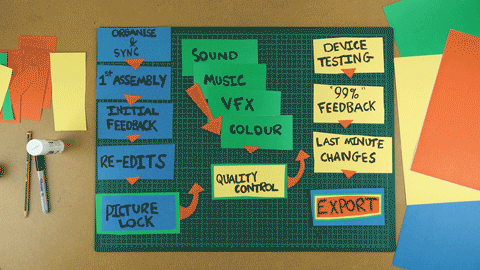A well-planned post-production workflow, even as a zero budget filmmaker, will save you a lot of time and prevent any hiccups during editing, sound design, VFX, and colour grading.
Once you have a picture lock, it’s time to share the edit and work on sound, music, VFX, and colour grading; and for some, this can be done all at the same time by a team of collaborators.
Last time, we spoke about organise and sync, first picture assembly, initial feedback, re-edits & picture lock.
So now you’ve made the decision to lock the edit. You are happy with the cut, and any other edits will be strictly for emergency changes. You’ve already gauged feedback from other filmmakers, you’ve made those changes, and now it’s time to move on.
This is where we can branch out. If you, alone, are the sound, VFX, music, and colour grading department, then you can follow these steps in a linear fashion. But if you are a team, it’s time to divide and conquer these tasks.
First, let’s talk a bit about VFX.
This is the only department which may need access to footage BEFORE the picture lock. The visual effects in the film will influence the sound design, music, and colour grading. So if it is at all possible, visual effects should be the first to get their hands on the edit.
If you already know which VFX need to be added to certain shots, the visual effects department can begin working during the editing process, but please be aware that some shots might be cut. So this is a balance between getting in there early and not wasting time on shots that won’t make the final cut.
Next we got sound design.
With an export of the edit, the sound department can start to work on Foley Art. Foley can be a long process as it includes re-recording all the run of the mill sounds in sync with the edit, and experimenting with sound effects libraries.
We’ve covered foley in a bunch of episodes in the past. There’s a card in the corner and a playlist in the description if you want to learn more.
In the meantime, a colourist can be working on the colour grade.
Just as sound design only needs the edit for sync points, colour grading doesn’t affect the sound in any way as it’s all visual, so these two can be easily worked on at the same time and brought together in the end.
Then you’ve got music.
A locked-picture will give the composer the exact timing to create and tweak the music throughout the film. Having the edit in front of them while they compose will also give them inspiration in the images.
There might be something in a scene which they want to harness and use as a musical device, so giving a composer the edit will let them work their magic to its full potential.
Visual Effects make this process of divide and conquer a little more complicated.
VFX is the only department that will cause the other departments further changes. If you are working on your own, I would suggest working on the visual effects before sound, colour grading, or music.
Once the VFX have been produced, extra sound effects will be added to the sound design, gunshots and explosions and spaceships for example. The colour grade might need tweaking once the VFX have been applied also.
Basically, every department will produce a another draft of their work with the final VFX in mind.
Once all the departments are finished, it’s time to put everything back together. This brings us to quality control.
Device testing and volume referencing are key contributors to a great looking and great sounding film. We’ve covered these topics in another video if you want to check it out. There’s a card in the corner and a link in the description.
Once you feel you’ve done everything you can with the film, it’s time for one last feedback stage: the 99% feedback stage.
Don’t say you are finished just yet! You might jynx it. Show the film to as many of your filmmaker friends as possible, or least the ones who give great critical feedback. You’ve already asked them but there might be something which they point out which nobody has before, so it’s worth doing one last check.
Make any last minute tweaks if the feedback requires it, then hit EXPORT. After this comes the hard part: convincing people to watch your movie!
This video was Sponsored By
🎵 http://bit.ly/tflpb-paranormalsynths - Click here to download this episode's track. Check out Premiumbeat.com to discover a huge range of exclusive royalty free music!
DISCLAIMERS:
Some of these links are affiliate links, if you purchase gear via these links The Film Look will receive a small commission, but there will be no additional cost to you. Thank you!







